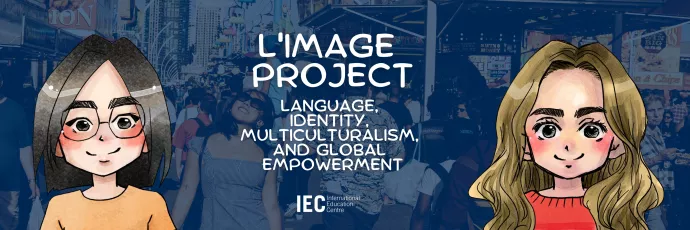
Introducing the L'IMAGE Project, a collaboration between the International Education Centre and Professor Ai Taniguchi of the Department of Language Studies at the University of Toronto Mississauga!
What's it about? Centred on linguistic empowerment, the project celebrates the diversity of our U of T students. By translating their stories and lived experiences into comics, we'll be contributing toward intercultural competency, empathy, and awareness that all forms of language are valid.
How does it work? A group of students volunteer to share their stories about the languages that they speak, and what role language has in their identity and everyday life. These stories will be illustrated as comics, complemented by infographics about language from the expert perspective of a linguist.
Why comics? Comics make information dissemination accessible: they are easy to read, understand, and share! As a tool that can be used widely across the three campuses, these comics can amplify the voices of linguistic-diverse and culture-diverse students at U of T.
What's the goal? We hope that U of T students see the shared and the different: there will be both linguistic experiences that they can relate to and ones they’ve never lived through. By finding common ground and seeing new perspectives, students’ linguistic and cultural viewpoints will be widened.
Scroll below to read our comics and visit lingcomics.com for more details!
Kelly's Story: Cantonese and Mandarin
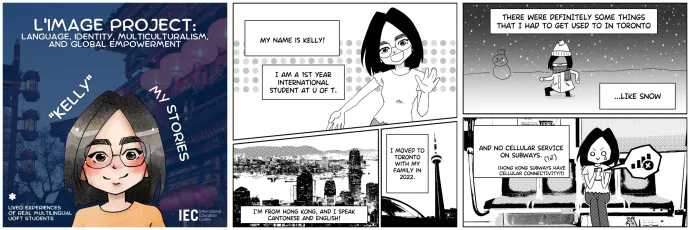
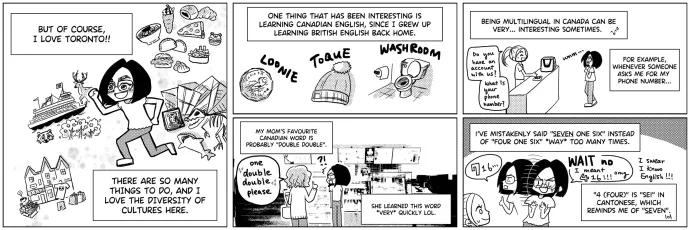
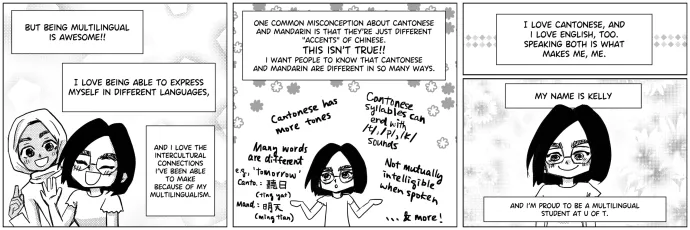
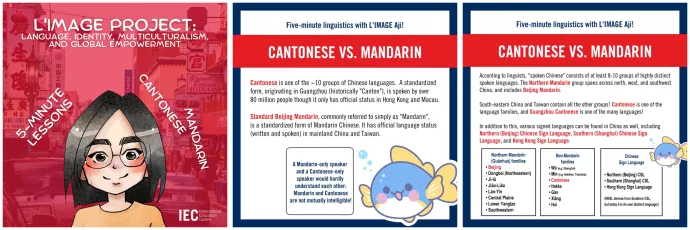
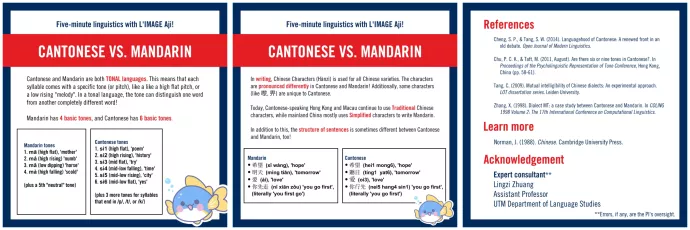
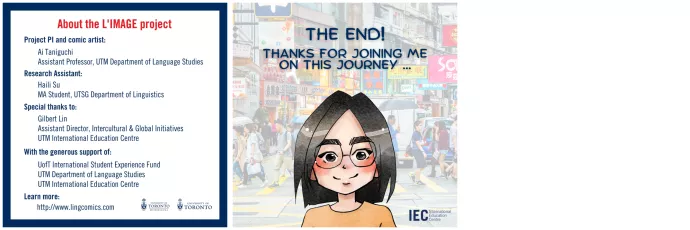
COMIC
[Page 1, Title Page]
Upper left corner of page reads: UofT L’IMAGE Project: Language, Identity, Multiculturalism and Global Empowerment
Subtitle over light blue box: The lived experiences of REAL multilingual students at UofT
Title over bright red box: KELLY’s story**
Under the title banners, the character Kelly smiles at the readers. She has shoulder-length straight black hair, light-to-medium skin tone, and wears octagon-shaped glasses. She is wearing an orange top with short flared sleeve.
Bottom left corner of page shows: the University of Toronto Mississauga logo and the University of Toronto logo.
Bottom right footnote: **Some stories in the L’IMAGE comic series employ pseudonyms at the request of the featured student.
[Long description of text and images in the comic strip:]
The comic strips in the L’IMAGE comic series uses the font Ames, which is the standard font for comics. Ames is an all-caps font. However, Alt-Texts for this project are not written in all-caps so that they will be more accessible for screen readers.
The comic artist for the series is Dr. Ai Taniguchi. Her drawing style can be described as: Japanese manga inspired, cute, large eyes, intentionally sketchy and unpolished line art, simplified, expressive. The comic strips are all digital, but she uses a pen that mimics the line weight of a traditional fountain pen. Her line art is on average 5mm in width (relatively thin), but the line weight varies and looks hand-drawn.
The title page of each comic strip is in color. It has a University of Toronto color scheme: navy blue, light blue, and bright red. The background is white with a navy blue frame. The references and acknowledgements page and the “About the L’IMAGE project” page also have this University of Toronto color scheme.
The comic strips themselves are black and white, and employ digital screen tones for shading and backgrounds.
[Page 2]
In the upper half panel: Kelly, smiling and waving at the readers, introduces herself:
“My name is Kelly!
I am a 1st year international student at U of T.”
In the bottom left panel: a photo of the Victoria Harbor of Hong Kong as seen from the Peak of Hong Kong island facing the direction of Kowloon Peninsula. The skyscrapers including the IFC buildings in the forefront. Kelly’s narration continues:
“I'm from Hong Kong, and I speak Cantonese and English!”
In the bottom right panel: a photo of CN Tower and Rogers Centre. Kelly’s narration continues:
“I moved to Toronto with my family In 2022.”
[Page 3]
In the upper panel: It is snowing outside. Kelly, in winter gears, is knee-deep in the snow on the ground. There is a snowman in the background. Kelly continues:
“There were definitely some things that I had to get used to in Toronto....like snow”
In the bottom panel: In a Toronto subway car, Kelly is sitting looking at her phone with a tear streaming down her face. A bubble shows that there is no cell signal. A mouse under the seat looks indifferent about the situation. Kelly’s narration continues:
“And no cellular service on subways. (Hong Kong subways have cellular connectivity!!)”
[Page 4]
The full panel: In the centre, an energized Kelly is running towards left. Surrounding her are different elements of Toronto: on the left, Toronto island ferry, raccoon, cherry trees and a deer; on the bottom left, townhouses with shops at Kensington market, with fruit stands, coffee, clothes; on the right, the Royal Ontario Museum Crystal extension, with a dinosaur fossil and a shark specimen; on the top right, different food signifying the culinary diversity of the city, including Ramen, ice cream, croissant and Anpan, pizza, pierogi, chicken sandwich, Xiaolongbao, Poutine, and a bear burger. Kelly’s narration continues:
“But of course, I love Toronto!! There are so many things to do, and I love the diversity of cultures here.”
[Page 5]
Top panel: Kelly’s narration: “One thing that has been interesting is learning Canadian English, since I grew up learning British English back home.” Three Canadian English expressions are shown along the narration with illustrative examples: “Loonie” a 1-Canadian-dollar coin, “Toque” a knit hat usually worn during the winter, also referred to as “Beanie”, “Washroom”, the common word for restroom or bathroom or toilet in Canada.
Bottom panel: Standing in front of a Tim Hortons café counter, a shocked Kelly is looking at her mother on the left. Kelly’s mother, with her back facing the readers, saying “One double double, please.”
Kelly’s narration: “My mom's favourite Canadian word is probably "double-double". she learned this word very quickly lol. (Emphasis on very)”
[Page 6]
Top panel: Kelly’s narration continues: “Being multilingual in Canada can be very interesting sometimes. for example, whenever someone asks me for my phone number...”
Kelly is at the cashier of a clothing store checking out. The smiling staff is asking: “Do you have an account with us? What is your phone number?”
Bottom panel: Kelly’s narration: “I’ve mistakenly said "seven one six" instead of "four one six" *way* too many times. four is "sei" in Cantonese, which reminds me of "seven"” We can see Kelly is making the mistake when telling the staff her phone number, then panicked and corrected herself, adding “I swear I know English!!”
[Page 7]
The full panel: Kelly is seen taking and laughing with a friend who is smiling and wearing a white hijab. Kelly’s narration continues: “but being multilingual is awesome!! I love being able to express myself in different languages, and I love the intercultural connections I’ve been able to make because of my multilingualism.”
[Page 8]
The full panel: a shrugging Kelly continues her narration: “one common misconception about Cantonese and Mandarin is that they’re just different “accents” of Chinese. this isn't true!! I want people to know that Cantonese and mandarin are different in so many ways.”
She lists different facts about the differences between Cantonese and Mandarin, including that Cantonese has more tones, Cantonese syllables can end with /t/, /p/, /k/ sounds, the two languages are not mutually intelligible when spoken, and that there are many different words, such as the word for “tomorrow” is “ting yat” in Cantonese and “ming tian” in Mandarin.
[Page 9]
Top panel: Kelly continues: “I love Cantonese, and I love English, too.
speaking both is what makes me, me.”
Bottom panel: Kelly, smiling and looking at the readers, says: “My name is Kelly. and I’m proud to be a multilingual student at U of T.”
[Page 10]
Page title: About the L’IMAGE project
Project PI and comic artist: Ai Taniguchi, Assistant Professor, UTM Department of Language Studies
Research Assistant: Haili Su, MA Student, UTSG Department of Linguistics
Special thanks to: Gilbert Lin, Assistant Director, Intercultural & Global Initiatives, UTM International Education Centre
With the generous support of: UofT International Student Experience Fund, UTM Department of Language Studies, UTM International Education Centre
Learn more: http://www.lingcomics.com
Bottom right of page shows the University of Toronto Mississauga logo and the University of Toronto logo.
INFOGRAPHIC
[Page 1]
Subtitle: Five-minute linguistics with L’IMAGE Aji!
Main title, over red banner: Cantonese vs. Mandarin
Cantonese is one of the ~10 groups of Chinese languages. A standardized form, originating Guangzhou (historically “Canton”), is spoken by over 80 million people though it only has official status in Hong Kong and Macau.
Standard Beijing Mandarin, commonly referred to simply as “Mandarin”, is a standardized form of Mandarin Chinese. It has official language status (written and spoken) in mainland China and Taiwan.
Cartoon image of “L’IMAGE Aji,” the project mascot, is seen smiling in bottom right of the page.
Speech bubble (Aji): A Mandarin-only speaker and a Cantonese-only speaker would hardly understand each other: Mandarin and Cantonese are not mutually intelligible!
[Long description of infographic pages:]
Each page of the infographic is in color. It has a University of Toronto color scheme: navy blue, light blue, and bright red.
L’IMAGE Aji is a fish character drawn in a style reminiscent of Sanrio characters like Hello Kitty. It is generally round in its silhouette and features. It has a pastel blue body with a yellow stripe, white belly, and yellow fins. It has two round eyes and round, pink blush on the cheeks, with a cat-like smiling mouth. There are bubbles coming out above it.
[Page 2]
Subtitle: Five-minute linguistics with L’IMAGE Aji!
Main title, over red banner: Cantonese vs. Mandarin
According to linguists, “Chinese” consists of at least 8-10 groups of highly distinct spoken languages. The Northern Mandarin group spans across north, west, and southwest China, and includes Beijing Mandarin.
South-eastern China and Taiwan contain all the other groups! Cantonese is one of the language families, and Guangzhou Cantonese is of the many languages!
In addition to this, various signed languages can be found in China as well, including Northern (Beijing) Chinese Sign Language, Southern (Shanghai) Chinese Sign Language, and Hong Kong Sign Language.
3 boxes at bottom of page.
Box 1 title: Northern Mandarin (Guānhuà) families. Box 1 text (bulleted list): Beijing, Dongbei (Northeastern), Jì-lǔ, Jiāo-Liáo, Lán-Yín, Central Plains, Lower Yangtze, Southwestern
Box 2 title: Non-Mandarin families. Box 2 text (bulleted list): Wú (e.g. Shanghai), Mǐn (e.g. Hokkien, Teochew), Cantonese, Hakka, Gàn, Xiāng, Huī
Box 3 title: Chinese Sign Language. Box 3 text (bulleted list): Northern (Beijing) CSL, Southern (Shanghai) CSL, Hong Kong Sign Language. (HKSL derives from Southern CSL, but today it is its own distinct language!)
L’IMAGE Aji is seen smiling at the upper right corner of Box 3.
[Page 3]
Subtitle: Five-minute linguistics with L’IMAGE Aji!
Main title, over red banner: Cantonese vs. Mandarin
Cantonese and Mandarin are both TONAL languages. This means that each syllable comes with a specific tone (or pitch), like a like a high flat pitch, or a low rising "melody". In a tonal language, the tone can distinguish one word from another completely different word!
Mandarin has 4 basic tones, and Cantonese has 6 basic tones.
2 boxes in bottom left corner.
Box 1 title: Mandarin tones. Box 1 text (numbered list): 1. mā (high flat), 'mother', 2. má (high rising) 'numb', 3. mǎ (low dipping) 'horse', 4. mà (high falling) 'scold'. (plus a 5th "neutral" tone)
Box 2 title: Cantonese tones. Box 2 text (numbered list): 1. si1 (high flat), 'poem', 2. si2 (high rising), 'history', 3. si3 (mid flat), 'try', 4. si4 (mid-low falling), 'time', 5. si5 (mid-low rising), 'city', 6. si6 (mid-low flat), 'yes'. (plus 3 more tones for syllables that end in /p/, /t/, or /k/)
L’IMAGE Aji is seen smiling in the bottom right of page.
[Page 4]
Subtitle: Five-minute linguistics with L’IMAGE Aji!
Main title, over red banner: Cantonese vs. Mandarin
In writing, Chinese Characters (Hànzì) is used for all Chinese varieties. The characters are pronounced differently in Cantonese and Mandarin! Additionally, some characters (like [Alt-Text note: these are traditional Chinese characters] 嚟, 畀) are unique to Cantonese.
Today, Cantonese-speaking Hong Kong and Macau continue to use Traditional Chinese characters, while mainland China mostly uses Simplified characters to write Mandarin.
In addition to this, the structure of sentences is sometimes different between Cantonese and Mandarin, too!
Two boxes at the bottom of the page.
Box 1 title: Mandarin. Box 1 text (bulleted list):
[Two Chinese characters] 希望 (xī wàng), 'hope'
[Two Chinese characters] 明天 (míng tiān), 'tomorrow'
[One Chinese character] 爱 (ài), 'love'
[Three Chinese characters] 你先走 (nǐ xiān zǒu) 'you go first', (literally 'you first go')
Box 2 title: Cantonese. Box 2 text (bulleted list):
[Two Chinese characters] 希望 (hei1 mong6), 'hope'
[Two Chinese characters] 聽日 (ting1 yat6), 'tomorrow'
[One Chinese character] 愛 (oi3), 'love'
[Three Chinese characters] 你行先 (nei5 hang4 sin1) 'you go first', (literally 'you go first')
[Long description of Chinese characters:] Each Chinese character is composed of a combination of strokes (or lines). The strokes can have various compositions: they could be relatively long, short, horizontal, vertical, completely straight, slightly curved, forming a box, intersecting each other, perpendicular to each other, and so on. Impressionistically, Chinese characters in general look angular rather than round. For example, the character for “yat” (the second character in ‘tomorrow’) looks like a rectangle, short side bottom, with a horizontal line in the middle of it. When compared to characters used in Mandarin, many of the characters used in Cantonese look more dense, with more strokes. For example, the character for “ting” (the first character in ‘tomorrow’ in Cantonese) is composed of 22 strokes. The character for “ming” (the first character in ‘tomorrow’ in Mandarin), on the other hand, is composed of 8 strokes.
[Page 5]
Section title: References
Cheng, S. P., & Tang, S. W. (2014). Languagehood of Cantonese: A renewed front in an old debate. Open Journal of Modern Linguistics.
Chu, P. C. K., & Taft, M. (2011, August). Are there six or nine tones in Cantonese?. In Proceedings of the Psycholinguistic Representation of Tone Conference, Hong Kong, China (pp. 58-61).
Tang, C. (2009). Mutual intelligibility of Chinese dialects: An experimental approach. LOT dissertation series. Leiden University.
Zhang, X. (1998). Dialect MT: a case study between Cantonese and Mandarin. In COLING 1998 Volume 2: The 17th International Conference on Computational Linguistics.
Section title: Learn more
Norman, J. (1988). Chinese. Cambridge University Press.
Section title: Acknowledgement
Expert consultant**, Lingzi Zhuang, Assistant Professor, UTM Department of Language Studies
**Errors, if any, are the PI’s oversight.
[Page 6]
Page title: About the L’IMAGE project
Project PI and comic artist: Ai Taniguchi, Assistant Professor, UTM Department of Language Studies
Research Assistant: Haili Su, MA Student, UTSG Department of Linguistics
Special thanks to: Gilbert Lin, Assistant Director, Intercultural & Global Initiatives, UTM International Education Centre
With the generous support of: UofT International Student Experience Fund, UTM Department of Language Studies, UTM International Education Centre
Learn more: http://www.lingcomics.com
Bottom right of page shows the University of Toronto Mississauga logo and the University of Toronto logo.
Sofiia's Story: Ukrainian
This story is coming soon, so stay tuned!
